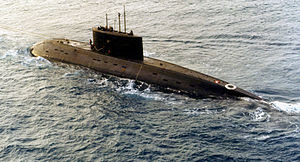Iran’s Submarine Force: The Undersea World Of Ali Khamenei – Analysis
By FPIF
By Scott Charney
In the middle of all the discussion of the possibility of attacks on Iran and a war in the Persian Gulf region, one factor in particular has been largely overlooked. The Iranians have evidently fallen in love with submarines. Brief news stories about the launch of new submarines have appeared repeatedly in the past few years, and yet this phenomenon receives only a passing mention in most articles and reports. No other country in the area (unless one counts Pakistan) operates any submarines. By contrast, the Iranians now could potentially have more than 20.
Obviously the Iranian naval establishment thinks it’s on to something, and that their near-term future lies beneath the waves. What do they have in mind?
What They Have

Accurate information about Iran’s submarine force is difficult to acquire. The announcements of new submarines often emanate from semi-governmental Iranian sources, which are known to boast about the capabilities of their indigenous weapons systems.For their part, international journalists often vary widely in their estimates of the size of Iran’s submarine force, with no consistent pattern emerging..
In the 1990s and shortly thereafter, the Iranians purchased three Kilo class submarines from Russia. These submarines are diesel-electric attack subs, well-known for being quiet. The Iranians subsequently began constructing their own midget submarines, with one craft of the Nahang class and many more of the Ghadirclass. The Iranians may also have acquired a few midget submarines from North Korea, though details are hazy, and these craft may no longer be operational. All of these midget subs can carry two torpedoes or anti-ship missiles, lay mines, and transport commando teams.
More recently, the Iranians seem to be seeking to bridge the gap between the midget subs and the Kilos by constructing what they call “semi-heavy” submarines of the Qaaem and/or Fateh class, with more possibly to come. Such submarines, if successful, could complement the Kilos at first and eventually supplant them when the larger submarines reach the end of their service lives. The upshot of all of this is that, even by the most conservative estimates, the Iranians have a sizable submarine force, are seeking to make it larger, and have a substantial head start over any of the other states bordering the Persian Gulf.
Why They Want Them
The reason for this submarine construction binge is very similar to the reason for Iran’s missile program: it circumvents their aerial deficiencies and, in so doing, creates a deterrent to attack. The Persian Gulf is mostly shallow and is littered with shipwrecks from centuries of traffic. Antisubmarine warfare is complicated in such an environment, and smaller submarines have particular advantages. All of the Arab states bordering the Persian Gulf have small navies, and suffering losses to Iranian submarines would leave these kings, sheiks, and emirs able to protect neither their exports of oil nor their imports of vast quantities of consumer goods. The Saudis have the most powerful navy in the region by far, but they are cursed by geography. Some of their most powerful ships are based at a port on the Red Sea, and transferring these elements to the Persian Gulf would necessitate sailing through the Straits of Hormuz. This would likely be a suicide mission in the face of Iran’s mines, submarines, shore-launched missiles, warships, air strikes, and so on.
The Arab air forces would surely attempt to eliminate Iran’s naval bases. But the Iranians have likely constructed missiles with that in mind. The multi-billion dollar air forces and navies of the Gulf states are concentrated at very few bases such that even an inaccurate missile is likely to land on something valuable.
In the case of a conflict with the United States, the Iranians could not win per se, but this is where deterrence comes into play. Before being overwhelmed and destroyed, Iranian submarines could conceivably sink one or more American ships and/or submarines, resulting in unacceptable casualties for the United States. This strategy is behind most of Iran’s recent military moves, and is common around the world. For this reason, among others, many current and retired American senior military officers oppose any attack on Iran. The military situation for the Israelis is similar. They would love to add the firepower of their own submarines’ cruise missiles to any strike on Iran, but risking the subs would be very foolish at a time of terrible relations with Turkey, upheaval in Syria, and an uncertain future with Egypt.
The Iranians would not have acquired so many submarines if they did not think they would come in handy. Thanks in part to these undersea craft, the regime in Tehran may have developed the ability to dominate its neighbors and ward off attack from faraway powers even as most of the foreign policy community has been chasing the specter of nuclear weapons.
Scott Charney is a contributor to Foreign Policy In Focus.

They are of the size that they have to return to base for resupply you just have to wait them out, even if it was a surprise attack. Which is what they are for. You get 70 80 days out of a nukes submarine in peace time before it needs resupply of food, using NASA space food, how long are those guys in space for before resupply. Peace time and war time two different things.